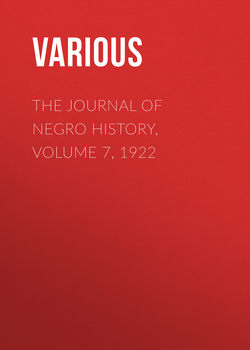Читать книгу The Journal of Negro History, Volume 7, 1922 - Various - Страница 6
The Journal of Negro History
Vol. VII—January, 1922—No. 1
EARLY NEGRO EDUCATION IN WEST VIRGINIA
The Strivings in Southern West Virginia
ОглавлениеIn southern West Virginia there were at first few schools for Negroes, inasmuch as the small Negro groups here and there did not warrant the outlay. What instruction such Negroes received prior to 1888 was largely private. That year an epoch was marked in the development of the southern portion of the State by the completion of the main line of the Norfolk and Western Railroad, opening up one of the largest coal fields in the United States. As the discontented Negroes of Virginia and North Carolina were eager for industrial opportunities in the mining regions of the Appalachian Mountains, these coal fields attracted them in large numbers. Bluefield, which developed in a few years from a barren field in 1888 to a town of almost ten thousand by 1900, indicates how rapidly the population there increased. Other large centers of industry, like Elkhorn, Northfork, Welch, and Keystone, soon became more than ordinary mining towns.
When these places had worn off the rough edges of frontier settlement and directed their attention to economic and social welfare, they naturally clamored for education. The first school for whites was established in Bluefield in 1889 and one for the Negroes, with Gordon Madson as teacher, followed in 1890. Prominent among the pioneering teachers in Bluefield were Mr. A. J. Smith and Mrs. L. O. McGhee, who began their work in a one-room log building in the suburbs of the town. About the end of the nineties there were Negro schools in most of the important mining towns along the Norfolk and Western Railroad between Bluefield and Williamson.
The Negro school in Bluefield had an interesting history. The school, of course, was poorly equipped and the teachers were not then adequately paid, but they continued their work two sessions of five months each. In the third year the school was moved to another town called Cooperstown where it was housed in a two-room building more comfortable than the first structure, but not a modern establishment. As it was situated in crowded quarters, the children had no playground. Several years thereafter, the work was continued by Mr. Patterson and Mrs. E. O. Smith. When, however, a large Negro population settled in North Bluefield it was necessary to provide there a two-room building between them. In this school-house taught Mr. P. J. Carter with an enrolment of about thirty pupils. Not long thereafter the building in the suburb of Cooperstown was burned. Two additional rooms were then annexed to that of North Bluefield, but before that could be occupied it was also destroyed in the same way. The Board of Education then opened a school, in a building used first as a bar-room, then as a pool-room, and finally as a courthouse. Thereafter an old store-room was used for four years.
There were then four teachers in Bluefield, Mr. H. Smith, Mr. T. P. Wright, Mesdames Lane, and E. C. Smith. In time Mr. Wright and Mr. Smith were replaced by Miss H. W. Booze, Mr. W. A. Saunders and Mr. R. A. McDonald. Mr. Saunders remained for one year and then was followed by Mr. G. W. Hatter who was in his turn succeeded by Mr. R. F. Douglass, who served as principal four years. Mr. Douglass had the board of education appropriate funds for a six-room building and increase the corps of teachers to five. By raising funds in the community through entertainments and the like, the teachers purchased a library of 100 volumes. In later years Mr. Douglass was followed by Mr. E. L. Rand, a graduate of Lincoln University.
At Keystone in 1890 Mr. J. A. Brown opened its first Negro school with an enrolment of about twenty-five. He was a man of fair education, but could not accomplish very much because the term was only three months in length. The school was held in one of the private houses belonging to the coal company and later in the church. In subsequent years there was very much development in the right direction, which proved the quality of the teachers employed in the school. Among these were Rev. J. Whittico, Mrs. Josephine D. Cannady, Mary A. McSwain, and Maggie Anderson. This school was later combined to form the Keystone-Eckman graded school, and now has an eight months' term and well-qualified teachers.52 A school had been established at Eckman in 1893 by James Knox Smith.
In November, 1892, one Moses Sanders at Northfork opened a school with an enrolment of twenty. He had only a rudimentary education. He served at Northfork for three terms using methods considered fair for that time, and his work, as a whole, was regarded as successful. He had there the support of such a useful person as Henry Glenn, now a member of the board of education.53 This school has later developed into a standard elementary graded school and a junior and senior high school of more than one hundred students. It has done well under the reorganization and direction of the efficient J. W. Robinson.
52
These facts were obtained from local records.
53
These facts were obtained from J. W. Robinson, the principal of the school.
